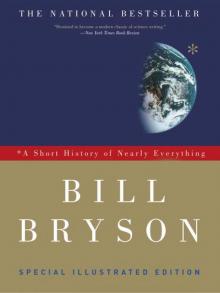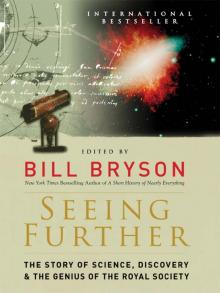- Home
- Bill Bryson
A Short History of Nearly Everything Page 2
A Short History of Nearly Everything Read online
Page 2
And so, from nothing, our universe begins.
In a single blinding pulse, a moment of glory much too swift and expansive for any form of words, the singularity assumes heavenly dimensions, space beyond conception. In the first lively second (a second that many cosmologists will devote careers to shaving into ever-finer wafers) is produced gravity and the other forces that govern physics. In less than a minute the universe is a million billion miles across and growing fast. There is a lot of heat now, ten billion degrees of it, enough to begin the nuclear reactions that create the lighter elements--principally hydrogen and helium, with a dash (about one atom in a hundred million) of lithium. In three minutes, 98 percent of all the matter there is or will ever be has been produced. We have a universe. It is a place of the most wondrous and gratifying possibility, and beautiful, too. And it was all done in about the time it takes to make a sandwich.
When this moment happened is a matter of some debate. Cosmologists have long argued over whether the moment of creation was 10 billion years ago or twice that or something in between. The consensus seems to be heading for a figure of about 13.7 billion years, but these things are notoriously difficult to measure, as we shall see further on. All that can really be said is that at some indeterminate point in the very distant past, for reasons unknown, there came the moment known to science as t = 0. We were on our way.
There is of course a great deal we don't know, and much of what we think we know we haven't known, or thought we've known, for long. Even the notion of the Big Bang is quite a recent one. The idea had been kicking around since the 1920s, when Georges Lemaître, a Belgian priest-scholar, first tentatively proposed it, but it didn't really become an active notion in cosmology until the mid-1960s when two young radio astronomers made an extraordinary and inadvertent discovery.
Their names were Arno Penzias and Robert Wilson. In 1965, they were trying to make use of a large communications antenna owned by Bell Laboratories at Holmdel, New Jersey, but they were troubled by a persistent background noise--a steady, steamy hiss that made any experimental work impossible. The noise was unrelenting and unfocused. It came from every point in the sky, day and night, through every season. For a year the young astronomers did everything they could think of to track down and eliminate the noise. They tested every electrical system. They rebuilt instruments, checked circuits, wiggled wires, dusted plugs. They climbed into the dish and placed duct tape over every seam and rivet. They climbed back into the dish with brooms and scrubbing brushes and carefully swept it clean of what they referred to in a later paper as "white dielectric material," or what is known more commonly as bird shit. Nothing they tried worked.
Unknown to them, just thirty miles away at Princeton University, a team of scientists led by Robert Dicke was working on how to find the very thing they were trying so diligently to get rid of. The Princeton researchers were pursuing an idea that had been suggested in the 1940s by the Russian-born astrophysicist George Gamow that if you looked deep enough into space you should find some cosmic background radiation left over from the Big Bang. Gamow calculated that by the time it crossed the vastness of the cosmos, the radiation would reach Earth in the form of microwaves. In a more recent paper he had even suggested an instrument that might do the job: the Bell antenna at Holmdel. Unfortunately, neither Penzias and Wilson, nor any of the Princeton team, had read Gamow's paper.
The noise that Penzias and Wilson were hearing was, of course, the noise that Gamow had postulated. They had found the edge of the universe, or at least the visible part of it, 90 billion trillion miles away. They were "seeing" the first photons--the most ancient light in the universe--though time and distance had converted them to microwaves, just as Gamow had predicted. In his book The Inflationary Universe , Alan Guth provides an analogy that helps to put this finding in perspective. If you think of peering into the depths of the universe as like looking down from the hundredth floor of the Empire State Building (with the hundredth floor representing now and street level representing the moment of the Big Bang), at the time of Wilson and Penzias's discovery the most distant galaxies anyone had ever detected were on about the sixtieth floor, and the most distant things--quasars--were on about the twentieth. Penzias and Wilson's finding pushed our acquaintance with the visible universe to within half an inch of the sidewalk.
Still unaware of what caused the noise, Wilson and Penzias phoned Dicke at Princeton and described their problem to him in the hope that he might suggest a solution. Dicke realized at once what the two young men had found. "Well, boys, we've just been scooped," he told his colleagues as he hung up the phone.
Soon afterward the Astrophysical Journal published two articles: one by Penzias and Wilson describing their experience with the hiss, the other by Dicke's team explaining its nature. Although Penzias and Wilson had not been looking for cosmic background radiation, didn't know what it was when they had found it, and hadn't described or interpreted its character in any paper, they received the 1978 Nobel Prize in physics. The Princeton researchers got only sympathy. According to Dennis Overbye in Lonely Hearts of the Cosmos , neither Penzias nor Wilson altogether understood the significance of what they had found until they read about it in the New York Times .
Incidentally, disturbance from cosmic background radiation is something we have all experienced. Tune your television to any channel it doesn't receive, and about 1 percent of the dancing static you see is accounted for by this ancient remnant of the Big Bang. The next time you complain that there is nothing on, remember that you can always watch the birth of the universe.
Although everyone calls it the Big Bang, many books caution us not to think of it as an explosion in the conventional sense. It was, rather, a vast, sudden expansion on a whopping scale. So what caused it?
One notion is that perhaps the singularity was the relic of an earlier, collapsed universe--that we're just one of an eternal cycle of expanding and collapsing universes, like the bladder on an oxygen machine. Others attribute the Big Bang to what they call "a false vacuum" or "a scalar field" or "vacuum energy"--some quality or thing, at any rate, that introduced a measure of instability into the nothingness that was. It seems impossible that you could get something from nothing, but the fact that once there was nothing and now there is a universe is evident proof that you can. It may be that our universe is merely part of many larger universes, some in different dimensions, and that Big Bangs are going on all the time all over the place. Or it may be that space and time had some other forms altogether before the Big Bang--forms too alien for us to imagine--and that the Big Bang represents some sort of transition phase, where the universe went from a form we can't understand to one we almost can. "These are very close to religious questions," Dr. Andrei Linde, a cosmologist at Stanford, told the New York Times in 2001.
The Big Bang theory isn't about the bang itself but about what happened after the bang. Not long after, mind you. By doing a lot of math and watching carefully what goes on in particle accelerators, scientists believe they can look back to 10 -43 seconds after the moment of creation, when the universe was still so small that you would have needed a microscope to find it. We mustn't swoon over every extraordinary number that comes before us, but it is perhaps worth latching on to one from time to time just to be reminded of their ungraspable and amazing breadth. Thus 10 -43 is 0.0000000000000000000000000000000000000000001, or one 10 million trillion trillion trillionths of a second. * 1
Most of what we know, or believe we know, about the early moments of the universe is thanks to an idea called inflation theory first propounded in 1979 by a junior particle physicist, then at Stanford, now at MIT, named Alan Guth. He was thirty-two years old and, by his own admission, had never done anything much before. He would probably never have had his great theory except that he happened to attend a lecture on the Big Bang given by none other than Robert Dicke. The lecture inspired Guth to take an interest in cosmology, and in particular in the birth of the universe.
The even
tual result was the inflation theory, which holds that a fraction of a moment after the dawn of creation, the universe underwent a sudden dramatic expansion. It inflated--in effect ran away with itself, doubling in size every 10 -34 seconds. The whole episode may have lasted no more than 10 -30 seconds--that's one million million million million millionths of a second--but it changed the universe from something you could hold in your hand to something at least 10,000,000,000,000,000,000,000,000 times bigger. Inflation theory explains the ripples and eddies that make our universe possible. Without it, there would be no clumps of matter and thus no stars, just drifting gas and everlasting darkness.
According to Guth's theory, at one ten-millionth of a trillionth of a trillionth of a trillionth of a second, gravity emerged. After another ludicrously brief interval it was joined by electromagnetism and the strong and weak nuclear forces--the stuff of physics. These were joined an instant later by swarms of elementary particles--the stuff of stuff. From nothing at all, suddenly there were swarms of photons, protons, electrons, neutrons, and much else--between 10 79 and 10 89 of each, according to the standard Big Bang theory.
Such quantities are of course ungraspable. It is enough to know that in a single cracking instant we were endowed with a universe that was vast--at least a hundred billion light-years across, according to the theory, but possibly any size up to infinite--and perfectly arrayed for the creation of stars, galaxies, and other complex systems.
What is extraordinary from our point of view is how well it turned out for us. If the universe had formed just a tiny bit differently--if gravity were fractionally stronger or weaker, if the expansion had proceeded just a little more slowly or swiftly--then there might never have been stable elements to make you and me and the ground we stand on. Had gravity been a trifle stronger, the universe itself might have collapsed like a badly erected tent, without precisely the right values to give it the right dimensions and density and component parts. Had it been weaker, however, nothing would have coalesced. The universe would have remained forever a dull, scattered void.
This is one reason that some experts believe there may have been many other big bangs, perhaps trillions and trillions of them, spread through the mighty span of eternity, and that the reason we exist in this particular one is that this is one we could exist in. As Edward P. Tryon of Columbia University once put it: "In answer to the question of why it happened, I offer the modest proposal that our Universe is simply one of those things which happen from time to time." To which adds Guth: "Although the creation of a universe might be very unlikely, Tryon emphasized that no one had counted the failed attempts."
Martin Rees, Britain's astronomer royal, believes that there are many universes, possibly an infinite number, each with different attributes, in different combinations, and that we simply live in one that combines things in the way that allows us to exist. He makes an analogy with a very large clothing store: "If there is a large stock of clothing, you're not surprised to find a suit that fits. If there are many universes, each governed by a differing set of numbers, there will be one where there is a particular set of numbers suitable to life. We are in that one."
Rees maintains that six numbers in particular govern our universe, and that if any of these values were changed even very slightly things could not be as they are. For example, for the universe to exist as it does requires that hydrogen be converted to helium in a precise but comparatively stately manner--specifically, in a way that converts seven one-thousandths of its mass to energy. Lower that value very slightly--from 0.007 percent to 0.006 percent, say--and no transformation could take place: the universe would consist of hydrogen and nothing else. Raise the value very slightly--to 0.008 percent--and bonding would be so wildly prolific that the hydrogen would long since have been exhausted. In either case, with the slightest tweaking of the numbers the universe as we know and need it would not be here.
I should say that everything is just right so far . In the long term, gravity may turn out to be a little too strong, and one day it may halt the expansion of the universe and bring it collapsing in upon itself, till it crushes itself down into another singularity, possibly to start the whole process over again. On the other hand it may be too weak and the universe will keep racing away forever until everything is so far apart that there is no chance of material interactions, so that the universe becomes a place that is inert and dead, but very roomy. The third option is that gravity is just right--"critical density" is the cosmologists' term for it--and that it will hold the universe together at just the right dimensions to allow things to go on indefinitely. Cosmologists in their lighter moments sometimes call this the Goldilocks effect--that everything is just right. (For the record, these three possible universes are known respectively as closed, open, and flat.)
Now the question that has occurred to all of us at some point is: what would happen if you traveled out to the edge of the universe and, as it were, put your head through the curtains? Where would your head be if it were no longer in the universe? What would you find beyond? The answer, disappointingly, is that you can never get to the edge of the universe. That's not because it would take too long to get there--though of course it would--but because even if you traveled outward and outward in a straight line, indefinitely and pugnaciously, you would never arrive at an outer boundary. Instead, you would come back to where you began (at which point, presumably, you would rather lose heart in the exercise and give up). The reason for this is that the universe bends, in a way we can't adequately imagine, in conformance with Einstein's theory of relativity (which we will get to in due course). For the moment it is enough to know that we are not adrift in some large, ever-expanding bubble. Rather, space curves, in a way that allows it to be boundless but finite. Space cannot even properly be said to be expanding because, as the physicist and Nobel laureate Steven Weinberg notes, "solar systems and galaxies are not expanding, and space itself is not expanding." Rather, the galaxies are rushing apart. It is all something of a challenge to intuition. Or as the biologist J. B. S. Haldane once famously observed: "The universe is not only queerer than we suppose; it is queerer than we can suppose."
The analogy that is usually given for explaining the curvature of space is to try to imagine someone from a universe of flat surfaces, who had never seen a sphere, being brought to Earth. No matter how far he roamed across the planet's surface, he would never find an edge. He might eventually return to the spot where he had started, and would of course be utterly confounded to explain how that had happened. Well, we are in the same position in space as our puzzled flatlander, only we are flummoxed by a higher dimension.
Just as there is no place where you can find the edge of the universe, so there is no place where you can stand at the center and say: "This is where it all began. This is the centermost point of it all." We are all at the center of it all. Actually, we don't know that for sure; we can't prove it mathematically. Scientists just assume that we can't really be the center of the universe--think what that would imply--but that the phenomenon must be the same for all observers in all places. Still, we don't actually know.
For us, the universe goes only as far as light has traveled in the billions of years since the universe was formed. This visible universe--the universe we know and can talk about--is a million million million million (that's 1,000,000,000,000,000,000,000,000) miles across. But according to most theories the universe at large--the meta-universe, as it is sometimes called--is vastly roomier still. According to Rees, the number of light-years to the edge of this larger, unseen universe would be written not "with ten zeroes, not even with a hundred, but with millions." In short, there's more space than you can imagine already without going to the trouble of trying to envision some additional beyond.
For a long time the Big Bang theory had one gaping hole that troubled a lot of people--namely that it couldn't begin to explain how we got here. Although 98 percent of all the matter that exists was created with the Big Bang, that matter consisted exclusi
vely of light gases: the helium, hydrogen, and lithium that we mentioned earlier. Not one particle of the heavy stuff so vital to our own being--carbon, nitrogen, oxygen, and all the rest--emerged from the gaseous brew of creation. But--and here's the troubling point--to forge these heavy elements, you need the kind of heat and energy of a Big Bang. Yet there has been only one Big Bang and it didn't produce them. So where did they come from?
Interestingly, the man who found the answer to that question was a cosmologist who heartily despised the Big Bang as a theory and coined the term "Big Bang" sarcastically, as a way of mocking it. We'll get to him shortly, but before we turn to the question of how we got here, it might be worth taking a few minutes to consider just where exactly "here" is.
2 WELCOME TO THE SOLAR SYSTEM
ASTRONOMERS THESE DAYS can do the most amazing things. If someone struck a match on the Moon, they could spot the flare. From the tiniest throbs and wobbles of distant stars they can infer the size and character and even potential habitability of planets much too remote to be seen--planets so distant that it would take us half a million years in a spaceship to get there. With their radio telescopes they can capture wisps of radiation so preposterously faint that the total amount of energy collected from outside the solar system by all of them together since collecting began (in 1951) is "less than the energy of a single snowflake striking the ground," in the words of Carl Sagan.
In short, there isn't a great deal that goes on in the universe that astronomers can't find when they have a mind to. Which is why it is all the more remarkable to reflect that until 1978 no one had ever noticed that Pluto has a moon. In the summer of that year, a young astronomer named James Christy at the U.S. Naval Observatory in Flagstaff, Arizona, was making a routine examination of photographic images of Pluto when he saw that there was something there--something blurry and uncertain but definitely other than Pluto. Consulting a colleague named Robert Harrington, he concluded that what he was looking at was a moon. And it wasn't just any moon. Relative to the planet, it was the biggest moon in the solar system.

 Notes from a Small Island
Notes from a Small Island A Short History of Nearly Everything
A Short History of Nearly Everything A Walk in the Woods
A Walk in the Woods I'm a Stranger Here Myself
I'm a Stranger Here Myself The Mother Tongue
The Mother Tongue Shakespeare
Shakespeare A Short History of Nearly Everything: Special Illustrated Edition
A Short History of Nearly Everything: Special Illustrated Edition The Best American Travel Writing 2016
The Best American Travel Writing 2016 The Road to Little Dribbling
The Road to Little Dribbling The Life And Times Of The Thunderbolt Kid: A Memoir (v5.0)
The Life And Times Of The Thunderbolt Kid: A Memoir (v5.0) Made In America
Made In America Seeing Further
Seeing Further Shakespeare: The World as Stage
Shakespeare: The World as Stage The Life and Times of the Thunderbolt Kid
The Life and Times of the Thunderbolt Kid At Home
At Home Bryson's Dictionary For Writers And Editors (v5.0)
Bryson's Dictionary For Writers And Editors (v5.0) Neither Here Nor There
Neither Here Nor There Bill Bryson's African Diary
Bill Bryson's African Diary